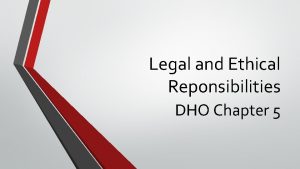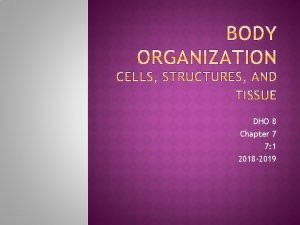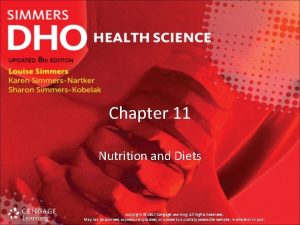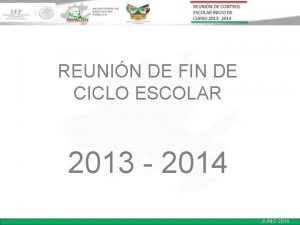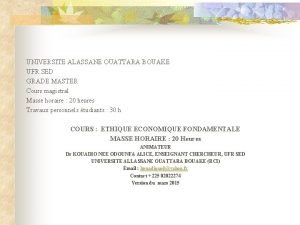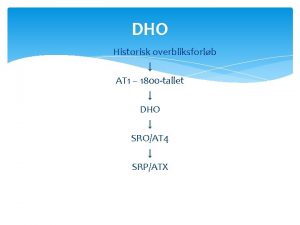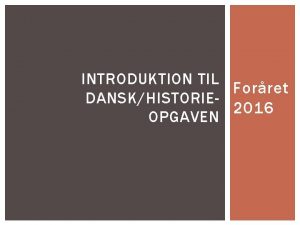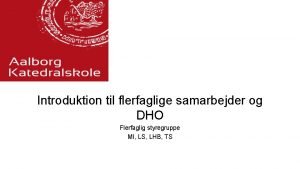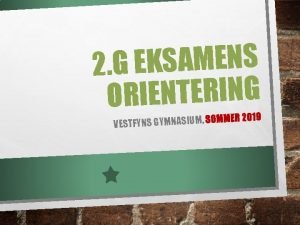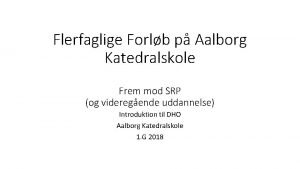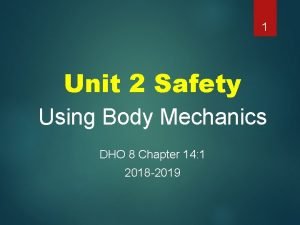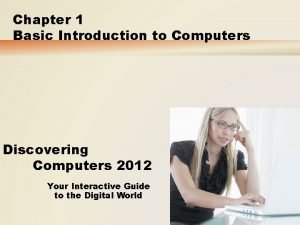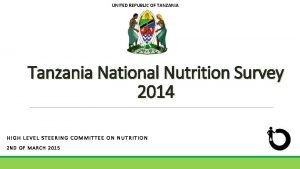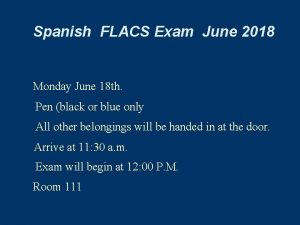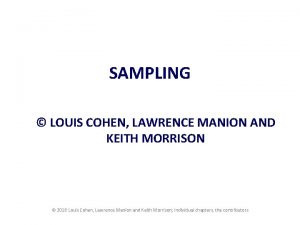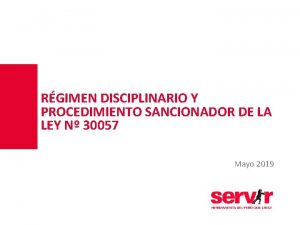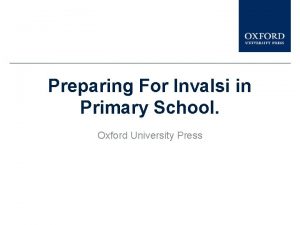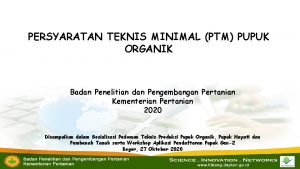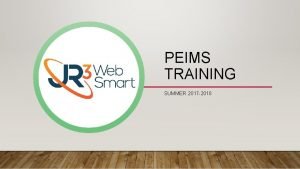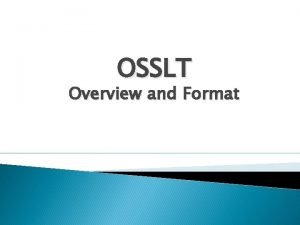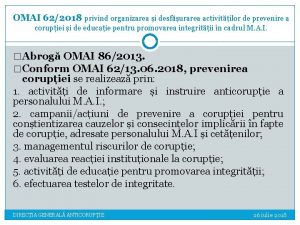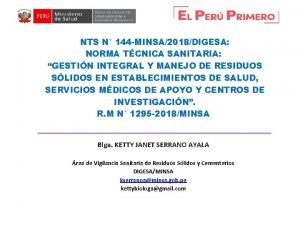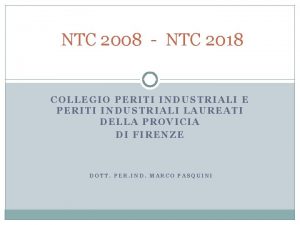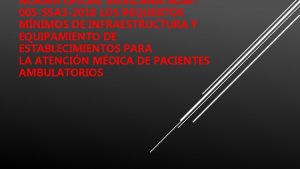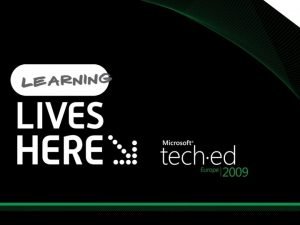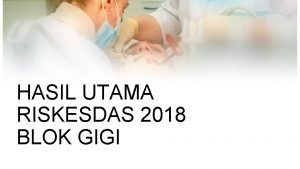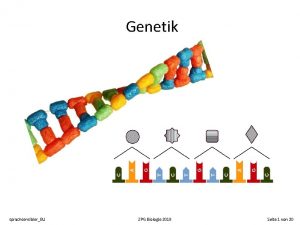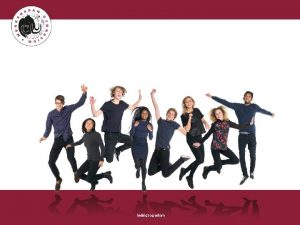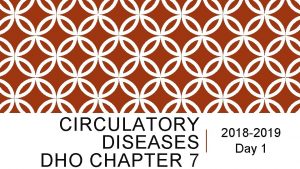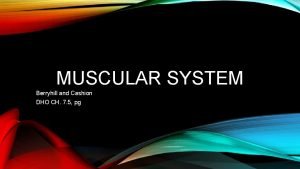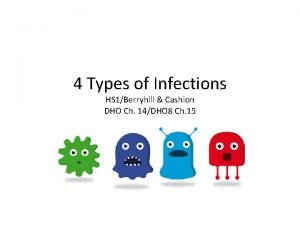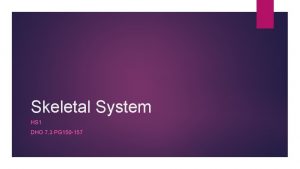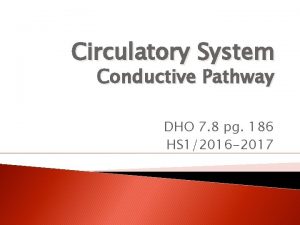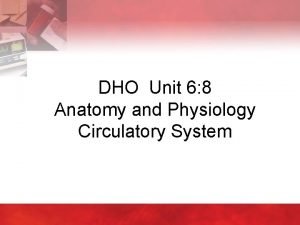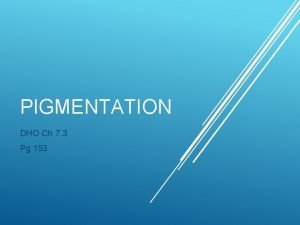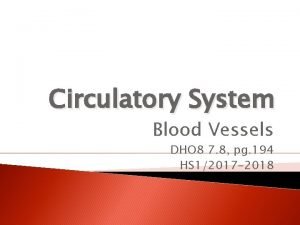DHO 8 Chapter 7 7 1 2018 2019

































































- Slides: 65

DHO 8 Chapter 7 7: 1 2018 -2019

� The normal function of the human body is compared to an organized machine � If the machine malfunctions, disease occurs � Anatomy: study of form and structure � Physiology: study of processes � Pathophysiology: study of how disease occurs and body’s response

Different types of diseases include: � Congenital=acquired during development of the infant in the uterus (cleft lip, spina bifida) � Inherited=transmitted from parents to child genetically (hemophilia, Down syndrome)

� Infectious=caused by a pathogenic organism such as a bacteria or virus (cold, STD) � Degenerative=caused by deterioration of the function/structure of body tissues & organs either by normal aging or lifestyle choices (COPD, osteoarthritis)

Other terms associated with disease: � Diagnosis=identifying the disease or stating what it is � Etiology=cause of the disease � Idiopathic=unkown � Prognosis=prediction of the probable course and/or the expected outcome of the disease

� Basic substance of life � Made of ordinary elements (carbon, oxygen, hydrogen, sulfur, nitrogen, phosphorus) � Scientists can combine these elements, but not create life

� Made of protoplasm which forms the basic structure and function of all living things � The CELL: Microscopic structures Ø Carry on all functions of life (food and oxygen, produce heat and energy, eliminate waste) Ø Body contains trillions of cells Ø Vary in shape and size Ø Perform different functions

� Cell membrane-outer protective cover and semipermiable � Cytoplasm-semifluid in the cell but outside the nucleus � Organelles-cell structures that help it function and located in cytoplasm � Nucleus-brain of the cell � Nucleolus-located inside the nucleus and important for cell reproduction � Chromatin-located in the nucleus and made of DNA and protein; forms chromosomes during cell reproduction

� Mitochondria-powerhouses of the cell; breakdown carbs, protein, fat to make ATP (energy source of cell) � Golgi apparatus-produces, stores, and packages secretions for discharge from cell � Endoplasmic reticulum-allows for transport of materials in and out of cell � Vacuoles-stores food or waste � Lysosomes-contain digestive enzymes for old cells, bacteria, and foreign materials

� Cells of same type joined together form tissue � Tissues are 60%– 99% water � This water is slightly salty and is called tissue fluid Ø Not enough tissue fluid=dehydration Ø Too much tissue fluid=edema

� 4 main groups of tissues �Epithelial �Connective �Nerve �Muscle

� Epithelial �covers tissue: the surface of the body and main tissue in skin �forms lining of intestinal, respiratory, circulatory, & urinary tracts �forms body glands where it specializes to produce secretions for the body like mucus & digestive juices

� Connective tissue is the supporting fabric of organs and other body parts. �There are 2 types: soft and hard

Soft connective tissue is divided into 2 types: adipose & fibrous connective tissue § Adipose tissue (fatty tissue) stores fat as a food reserve or source of energy & acts as padding § Fibrous connective tissue helps hold body structures together (ligaments & tendons)

� Hard connective tissue includes cartilage and bone �Cartilage is a tough, elastic material found between the bones of the spine & at the ends of long bones. It acts as shock absorber and allows for flexibility. It is also found in the nose, ears, & larynx �Bone (osseous tissue) forms rigid structure of body

� There is also a class of connective tissue called liquid connective tissue (vascular tissue) �It includes blood and lymph – they transport substances in the body

� Nerve tissue �controls and coordinates body activities by transmitting messages though the body �Nerves, brain, & spinal cord are made of nerve tissue

� Muscle tissue �produces power and movement by contraction of muscle fibers. �There are 3 main kinds of muscle tissue: skeletal, cardiac, visceral/smooth

� Muscle tissue Ø Skeletal which attaches to bones and provides movement Ø Cardiac which causes heart to beat Ø Visceral/smooth which is walls of respiratory, digestive, urinary tract, and blood vessels

� Organs: two or more tissues joined together for a specific purpose � Organ Systems: organs and other body parts joined together for a particular function


�Cells combine to form tissue �Tissues combine to form organs �Organs combine to form systems �Systems work together to form the organism


There are 11 basic systems: Ø Ø Ø Integumentary Skeletal Muscular Circulatory Lymphatic Respiratory Digestive Urinary Nervous Endocrine Reproductive

� Which of the following is a type of muscle tissue? A) Smooth B) Squamous C) Osseous D) Carotid And the answer is…. A

� Where would you find epithelial tissue? A) Inside long bones B) Inside the brain C) Lining the inside of the nose D) In the walls of the large intestine And the answer is…. C

� What type of tissue transmits messages from the head to the toes? A) Connective B) Epithelial C) Nerve D) Muscle And the answer is…C

� What type of tissue is classified as hard or soft? A) Epithelial B) Muscle C) Nervous D) Connective And the answer is…D

� What is the primary function of muscle tissue? A) To produce movement B) To control and coordinate body activities C) Transportation D) To produce body secretions And the answer is…A

� Blood is classified as what type of tissue? A) Epithelial B) Connective C) Nerve D) Muscle And the answer is…B

� Of the following, which is the MOST complex? A) Nucleus B) Muscle tissue C) Nerve cell D) Kidney And the answer is…D

� Which organ or structure does NOT belong with the other three? A) Stomach B) Heart C) Liver D) Mouth And the answer is…B

DHO 8 Chapter 7 7: 2 2018 -2019

� Anatomic positionstanding upright, facing forward, arms at the sides with palms facing forward

� Body planes: imaginary lines drawn through body at various levels to separate body into sections (3 main planes) � Directional terms are created by planes (12 terms) � Body planes & directional terms were developed to describe the relationship of one part of the body to another (must be in anatomic position)

Body plane #1: Transverse plane: horizontal plane that divides the body into top and bottom halves. It creates the following 4 directional terms: � Superior-top half (knee is superior to ankle) � Inferior-bottom half (knee is inferior to hip) � Cranial-towards the head � Caudal-towards the tail (sacral region of spinal column)

Body plane #2 Midsagittal (median) plane: vertical plane that divides body into left and right sides It creates the following 2 directional terms: � Medial-body parts close to the midline � Lateral-body parts away from the midline

Body plane #3 Frontal (coronal) plane: vertical plane divides the body into front and back section It creates the following directional terms: �Ventral or Anterior-body parts on the front of the body �Dorsal or Posterior-body parts on the back of the body

� Last 2 directional terms are proximal & distal. � These are used to describe the location of the extremities (arms & legs) in relation to the main body trunk � The main body trunk is called the point of reference � Proximal-body parts close to the point of reference � Distal-body parts distant from the point of reference


� Get your white boards and markers ready to answer review questions!

� If the body were cut in a transverse plane, what organ would NOT be in the same half as the other three? A) Brain B) Bladder C) Lungs D) Heart And the answer is…. B

� What A) B) C) D) body part is inferior to the chest? Head Neck Heart Hips And the answer is…D

� If you divided the body with a midsagittal plan and added up the number of eyes, arms, and toes on one side, how many would you have? A) B) C) D) 5 7 9 12 And the answer is…B

� An autopsy photo shows the dorsal side of the victim. What could you see in the photo? A) B) C) D) Back of the head Kidneys Knees Front of the abdomen And the answer is…A

� Of the following, which structures are the most medial? A) B) C) D) Ears Hips Eyes Lips And the answer is…D

� What A) B) C) D) body parts are distal to the hand? Fingers Eyes Ribs Lungs And the answer is…A

� What A) B) C) D) structure is proximal to the thigh? Ankle Calf Hip Foot And the answer is…C

DHO 8 Chapter 7 7: 2 2018 -2019

� Body cavities: spaces within the body that contain vital organs � There are 2 main cavities Ø Dorsal or posterior cavity Ø Ventral or anterior cavity � And there are 3 small cavities Ø Orbital cavity-contains eyes Ø Nasal cavity-contains nose structures Ø Buccal cavity-(mouth)-teeth & tongue

� Dorsal cavity is one long, continuous cavity on the back of the body � It can be broken down into 2 sections: cranial cavity and spinal cavity Ø Cranial cavity holds the brain Ø Spinal cavity holds the spinal cord

� Ventral cavity long cavity on the front of the body � It is separated into 2 distinct cavities by the diaphragm muscle �Thoracic cavity is the upper cavity located in the chest and contains the esophagus, trachea, bronchi, lungs, heart, and large blood vessels �Abdominal cavity (abdominopelvic cavity) is the lower cavity below the diaphragm muscle

� Abdominal cavity is divided into an upper part and a lower part �Upper abdominal cavity contains the stomach and a large part of digestion system �Lower abdominal cavity (pelvic cavity) has the urinary bladder, reproductive organs, and last part of large intestine

� The kidneys and the adrenal glands are located outside the abdominal cavity and behind the peritoneal membrane � This area is called the retroperitoneal space


� What structures are located anterior to the cranial cavity? A) B) C) D) Eyes Ears Lungs Neck muscles And the answer is…A

� What body cavity contains the brain and spinal cord? A) B) C) D) Cranial Spinal Dorsal Ventral And the answer is…C

� What cavity would a surgeon enter to repair a heart defect? A) B) C) D) Dorsal Thoracic Abdominal Pelvic And the answer is…B

� If a physician performs a pelvic exam, what organs can be evaluated? A) B) C) D) Respiratory Reproductive Esophagus and stomach Liver and gallbladder And the answer is…B

� Abdominal cavity is separated into quadrants or regions because it is so large � Quadrants divide the abdominal cavity into 4 sections: Ø RUQ-right upper quadrant Ø LUQ-left upper quadrant Ø RLQ-right lower quadrant Ø LLQ –left lower quadrant

�A more precise way of describing the abdominal cavity is with 9 regions, looking like a tic-tac-toe board. � Epigastric-center above stomach � Umbilical-center at navel � Hypogastric-center below stomach � Hypochondriac-sides below ribs (R & L) � Lumbar-sides and same as spinal column (R & L) � Iliac or inguinal-bottom near the groin (R & L)



� If a physician writes that the patient has RUQ pain, what might be causing it? A) B) C) D) Head injury Arthritis in the hip Cracked rib Dislocated shoulder And the answer is…C

�Positive and negative feedback �Transport �p. H acids and bases �Temperature regulation �Glucose regulations
 Dho chapter 5 legal and ethical responsibilities
Dho chapter 5 legal and ethical responsibilities Dho chapter 7
Dho chapter 7 Dho chapter 11 nutrition and diets
Dho chapter 11 nutrition and diets Dho chapter 4
Dho chapter 4 B a f c j e
B a f c j e Conest control escolar
Conest control escolar Resultat ufr sed 2018-2019
Resultat ufr sed 2018-2019 Sop skabelon dansk
Sop skabelon dansk Dho hhx
Dho hhx 7:11 digestive system diagram
7:11 digestive system diagram Dho emner
Dho emner Disposition dho
Disposition dho Dho 1.g
Dho 1.g Dho kvinders rettigheder
Dho kvinders rettigheder Dho problemformulering eksempel
Dho problemformulering eksempel Akademisk resume
Akademisk resume Dho opbygning
Dho opbygning Kommer dho på eksamensbevis
Kommer dho på eksamensbevis Kildehenvisning srp
Kildehenvisning srp Broad base of support
Broad base of support Discovering computers 2018 ppt
Discovering computers 2018 ppt Discovering computers 2018 chapter 1
Discovering computers 2018 chapter 1 Discovering computers 2018 chapter 1
Discovering computers 2018 chapter 1 Energieübertragungsketten
Energieübertragungsketten Ybl2018
Ybl2018 Working together to safeguard children 2018
Working together to safeguard children 2018 Saasta astro quiz 2018 questions and answers
Saasta astro quiz 2018 questions and answers Saasta astro quiz 2019 questions and answers
Saasta astro quiz 2019 questions and answers Astro quiz 2018 questions and answers
Astro quiz 2018 questions and answers Crmug phoenix
Crmug phoenix Forrester wave data governance
Forrester wave data governance Tanzania national nutrition survey 2020
Tanzania national nutrition survey 2020 Tanzania national nutrition survey 2020
Tanzania national nutrition survey 2020 Tungsten fabric
Tungsten fabric Pldvs
Pldvs Spsp 2018
Spsp 2018 Spanish flacs exam 2018 answers
Spanish flacs exam 2018 answers Legea 270 din 2018 cu modificari
Legea 270 din 2018 cu modificari Cohen manion and morrison 2018
Cohen manion and morrison 2018 Informe técnico 2005-2016-servir/gpgsc
Informe técnico 2005-2016-servir/gpgsc Resolución 583 de 2018
Resolución 583 de 2018 Pnp mc 2018-050
Pnp mc 2018-050 Www dte com lsp
Www dte com lsp Oxford invalsi practice test for english 2018 listening
Oxford invalsi practice test for english 2018 listening Persyaratan teknis minimal pupuk organik
Persyaratan teknis minimal pupuk organik Perlem 9 tahun 2018
Perlem 9 tahun 2018 Tsds peims 2017 2018
Tsds peims 2017 2018 2018 dsr
2018 dsr Osslt 2018 practice test
Osslt 2018 practice test Omai 62 din 2018
Omai 62 din 2018 Nts 144 minsa 2018
Nts 144 minsa 2018 Classe d'uso ntc 2018
Classe d'uso ntc 2018 Opanaf 1825 din 2018
Opanaf 1825 din 2018 Nom 005 ssa3 2018
Nom 005 ssa3 2018 Nys math test 2016
Nys math test 2016 Techchecklessons 2018
Techchecklessons 2018 Nbr 6023:2018
Nbr 6023:2018 2018 nds
2018 nds Gamsat dates
Gamsat dates Group policy change management
Group policy change management Program kerja dpp
Program kerja dpp Snieguma līmeņu apraksti
Snieguma līmeņu apraksti Jan 2018 chem regents
Jan 2018 chem regents Riskesdas 2018 gigi dan mulut
Riskesdas 2018 gigi dan mulut Geometry regents 2019
Geometry regents 2019 Zpg biologie 2018
Zpg biologie 2018
